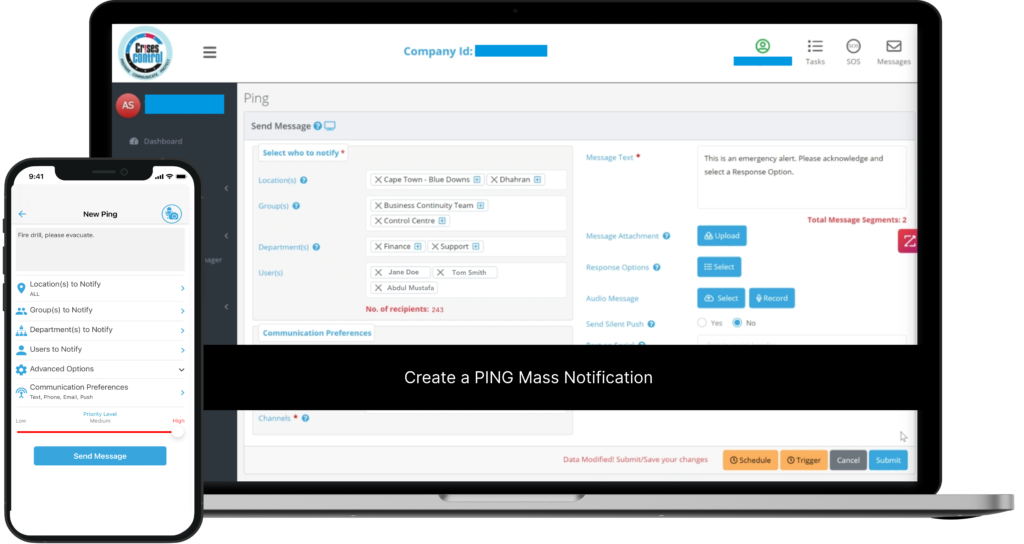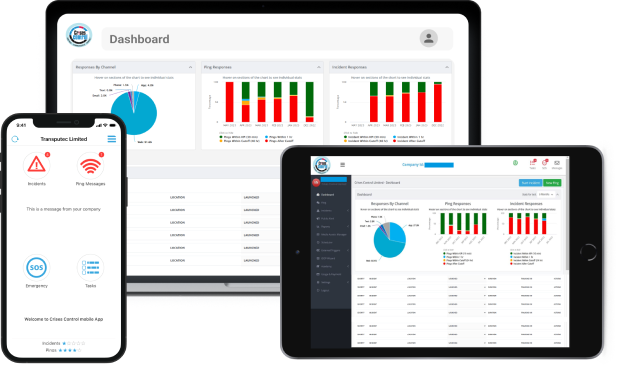Written by Anneri Fourie | Marketing Executive
In 2024, workplaces are no longer confined to a single building or location. Teams now operate across cities, countries, and even continents, and while this offers flexibility and efficiency, it also brings new challenges—especially when it comes to ensuring safety during a crisis.
For managers responsible for distributed teams, the stakes are high. Delayed communication, incomplete information, or unclear instructions during an emergency can result in confusion, harm, or worse. This blog delves into how Mass Communication Software can bridge these gaps, enhancing workplace safety for remote and dispersed teams.
What Is Mass Communication Software?
At its core, mass communication software is a digital platform designed to send timely, targeted messages to large groups of people. Unlike traditional methods such as emails or phone chains, this software ensures consistency, speed, and clarity across all communication channels.
For organisations with employees spread across multiple locations, mass communication software acts as a central hub, delivering critical updates in real time. It ensures every team member receives the same message, regardless of where they are.
The Challenges of Protecting Distributed Teams
Managing workplace safety across dispersed teams is no small task. Here are some common hurdles:
- Delayed Responses: Without a reliable system, delays in passing along critical information can escalate emergencies.
- Limited Reach: Traditional methods often fail to connect with remote employees, especially those in areas with poor connectivity.
- Communication Overload: Uncoordinated updates from multiple sources can overwhelm employees, making it harder to act.
- Tracking Issues: It can be challenging to confirm who has received and acted on vital information.
These challenges highlight why modern organisations need a more effective communication solution.
How Mass Communication Software Enhances Workplace Safety
Mass communication software goes beyond simply sending messages—it creates a comprehensive safety net for teams. Here’s how:
1. Real-Time Alerts for Quick Action
Emergencies demand immediate responses. Whether it’s a fire, severe weather, or a security threat, mass communication software ensures employees are notified within seconds. Alerts are delivered via SMS, email, mobile push notifications, and voice calls, ensuring no time is wasted.
2. Precision Through Geotargeting
Not all employees need the same information during a crisis. Geotargeting allows managers to send location-specific alerts to individuals in affected areas. For example, employees near a flood zone can receive evacuation instructions, while others are updated about operational changes.
3. Multi-Channel Communication
Mass communication software uses various channels to deliver messages, ensuring they reach employees even if one method fails. If an email doesn’t go through, an SMS or push notification can fill the gap, increasing reliability during emergencies.
4. Two-Way Communication
Safety is a two-way street. Mass communication software enables employees to confirm their safety or request help with a simple response. This feature provides managers with real-time updates, allowing them to direct resources where needed most.
5. Integration with Crisis Management Tools
Advanced mass communication platforms, like Crises Control, seamlessly integrate with incident management systems. This ensures that communication doesn’t happen in isolation, but is part of a coordinated crisis response strategy.
How Crises Control Leads the Way
Crises Control offers a powerful suite of tools designed to simplify and enhance workplace safety for distributed teams. Let’s explore its standout features:
1. Ping Mass Notification System
Crises Control’s Ping system delivers instant alerts across multiple channels. Whether it’s an emergency update or a routine safety reminder, every employee stays informed, no matter where they are.
2. Geofencing for Targeted Messaging
With geofencing, Crises Control enables precise communication. Managers can tailor alerts based on an employee’s location, ensuring that messages are relevant and reduce unnecessary panic.
3. SOS Panic Button
Safety is personal, and the SOS Panic Button empowers employees to take immediate action when they feel threatened or unsafe. With a single tap, they can alert their managers and request assistance.
4. Incident Plan Builder
Planning ahead is crucial. The Incident Plan Builder breaks down complex crisis responses into clear, actionable steps that employees can follow with confidence, even under pressure.
5. Reporting and Audit Trails
Crises Control provides real-time reports and post-incident audits. Managers can track who received alerts, monitor responses, and identify areas for improvement in their safety protocols.
6. Seamless Integration
The platform integrates smoothly with existing systems, ensuring organisations can enhance their communication without disrupting current workflows.
Interested in our Ping Mass Communication Software?
Efficiently alert everyone in seconds at scale with our Mass Communication Software – PING, get the message out fast and ensure rapid response and recovery.

Real-World Impact: A Case Study
Consider the example of a multinational logistics company. With teams operating across regions, they struggled to communicate effectively during emergencies.
Challenge: During a severe weather event, delays in communication led to operational disruptions and employee confusion.
Solution: The company adopted Crises Control’s Ping Mass Notification System to deliver real-time, location-specific alerts.
Outcome: Employees in the affected area received evacuation instructions within minutes, while others were updated about alternative work arrangements. The crisis was managed effectively, with minimal disruption.
How to Make Mass Communication Software Work for Your Team
Here are practical steps for managers to enhance workplace safety using mass communication software:
- Understand Team Needs: Identify specific communication challenges your organisation faces and tailor solutions accordingly.
- Choose the Right Platform: Opt for a comprehensive solution like Crises Control that offers multi-channel delivery, geotargeting, and incident management integration.
- Train Employees Regularly: Familiarise your team with the software and communication protocols through regular training sessions.
- Test Your System: Conduct regular drills and tabletop exercises to evaluate your crisis response and make necessary adjustments.
Conclusion: Secure Your Team’s Safety Today
Workplace safety isn’t optional—it’s essential. With the right mass communication software, organisations can safeguard their distributed teams, ensure timely responses during crises, and build resilience against unexpected challenges.
Crises Control offers a tailored solution for modern workplaces, combining advanced features with user-friendly design. Don’t wait for a crisis to reveal the gaps in your communication strategy.
Take the first step today. Contact us for a free personalised demo and discover how Crises Control can keep your team informed, safe, and prepared.
Request a FREE Demo

